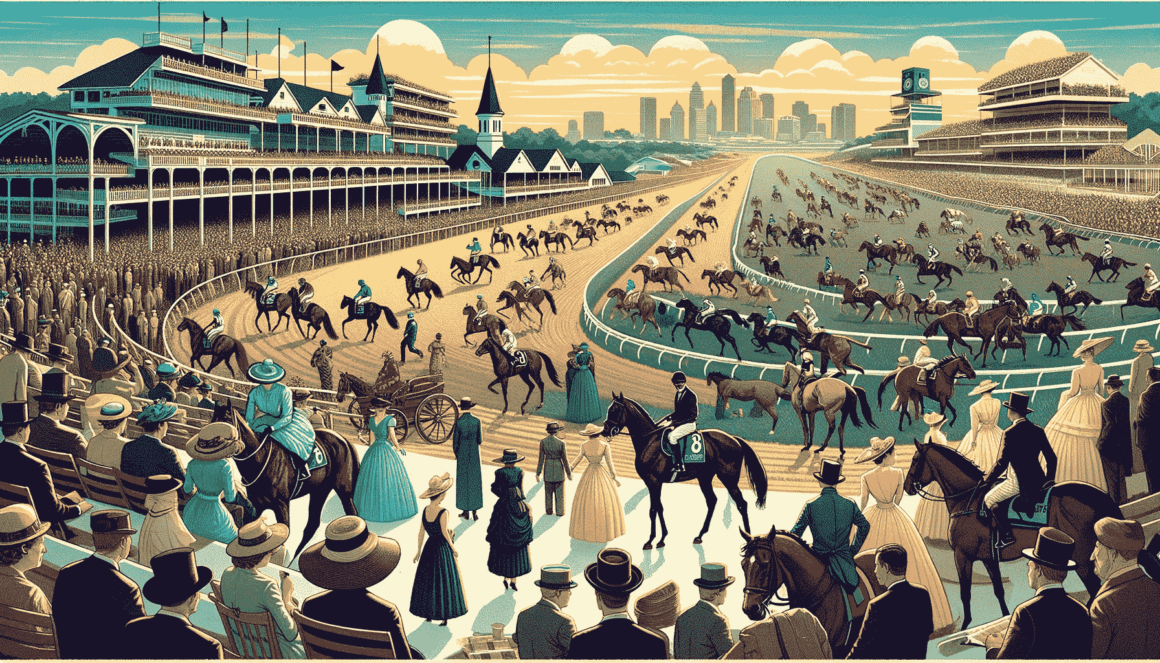Kentucky Derby History: 20 Facts About the Legendary Event
The Kentucky Derby is one of the most prestigious thoroughbred racing events in the world, and America’s premier sporting event, on par with the Super Bowl. Held at the Churchill Downs Racetrack in Louisville, Kentucky, it’s a 1.25-mile race for three-year-old horses that is often called “the most exciting two minutes in sports.”
Since 1875, every first Saturday in May, people have donned their fancy hats and sipped mint juleps to watch the most famous horse race in the world.
In this post, we’ll share the most interesting tidbits of knowledge about this race that fans would appreciate. Read on!
A Short Kentucky Derby Timeline

(Kentucky Derby)
1874 — Colonel Meriwether Lewis Clark acquired the land for the Churchill Downs racetrack from John and Henry Churchill, his uncles.
1875 — The very first Kentucky Derby took place on May 17. A Black jockey, Oliver Lewis, rode Aristides to victory in the inaugural race.
1894 — A 285–foot grandstand was added to welcome a larger audience.
1896 — The derby’s length was shortened from a mile and a half to one-and-a-quarter miles, and a wreath of white-and-pink roses was given to the winner for the first time.
1924 — The thoroughbred horse Black Gold was the first winner to receive the Derby trophy as we know it today. It was also when one of the biggest Kentucky Derby traditions started, as “My Old Kentucky Home” was sung before the start of the race for the first time.
1919 — Sir Barton wins and becomes the first horse to win the Triple Crown by finishing first in three races – the Kentucky Derby, Preakness Stakes, and Belmont Stakes – although this achievement wasn’t called that yet.
1925 — The first live radio broadcast of the Derby happened, and the term “Run for the Roses” was invented by a New York Evening Journal sports columnist, Bill Corum.
1930 — The term Triple Crown winner was used for the first time, for the second horse to win the Belmont Stakes, Preakness Stakes, and Kentucky Derby.
1932 — The iconic garland of red roses – the Derby’s official flower – was used to drape the winning horse for the first time.
1938 — The infield was constructed so more local race fans could watch the race.
1949 — The Kentucky Derby was locally broadcast on TV for the first time.
1968 — Dancer’s Image tested positive for illegal medication and became the first winning horse to be disqualified from the Derby.
1970 — The first female jockey, Diane Crump, competed in the Derby.
1973 — The current speed record was set by Secretariat, a legendary thoroughbred racehorse and the only horse who was also a Triple Crown winner to set a top-10 record.
2015 — The Derby had its highest attendance ever, with 170,513 spectators.
2018 — After American Pharoah broke the 30-year Triple Crown drought in 2015, Justify becomes the next Triple Crown winner.
The History of the Kentucky Derby
The Kentucky Derby is the longest-running sporting event in American history. The following section will present the most important part of its illustrious run.
1. The first Kentucky Derby was held in 1875.
(Kentucky Derby)
Meriwether Lewis Clark Jr., the grandson of the explorer William Clark, went on a trip to Europe in 1872. Inspired by European horse races, the Epsom Derby, and the French Jockey Club, he established the Louisville Jockey Club and raised money to construct a racing field.
He bought the land from John and Henry Churchill, his uncles, and named the racetrack Churchill Downs some years later. The inaugural derby was held in 1875. It was held on May 17 in front of 10,000 spectators with 15 horses.
2. Black jockeys used to dominate the early Derbies.
(History)
Another interesting Kentucky Derby fact is that, initially, most jockeys were Black. However, by the beginning of the 20th century, Black jockeys were practically driven out of the competition due to the envy and prejudice of white riders. Jimmy Winkfield was the last Black jockey to win the Derby in 1902.
3. Secretariat, the fastest of all winning horses in the Derby, was the only horse to feature on the covers of both Time magazine and Sports Illustrated.
(Horsey Hooves)
In 1973, a horse named Secretariat managed to win the Triple Crown with a passing time of 1:59:40 and set the current record.
Below you can see Secretariat’s and other top 9 Kentucky Derby horse stats.
| Rank | Horse | Passing time | Year |
| 1 | Secretariat | 1:59.40 | 1973 |
| 2 | Monarchos | 1:59.97 | 2001 |
| 3 | Northern Dancer | 2:00 | 1964 |
| 4 | Spend a Buck | 2:00.20 | 1985 |
| 5 | Decidedly | 2:00.40 | 1962 |
| 6 | Proud Clarion | 2:00.60 | 1967 |
| 7 | Authentic | 2:00.61 | 2020 |
| 8 | Medina Spirit | 2:01.02 | 2021 |
| 9 | Grindstone | 2:01.06 | 1996 |
| 10 | Fusaichi Pegasus | 2:01.12 | 2000 |
4. The biggest upset in Kentucky Derby history happened in 1970 when the first woman competed.
(The Washington Post)
In the late 1960s, it was unimaginable for a woman to compete in the Derby, regardless of her track record. Whenever it was announced a woman would be a jockey, there were boycotts, and she couldn’t compete after all.
However, on the first Saturday in May 1970, despite boycotts from other jockeys and the audience, Diane Crump stepped onto the racetrack at Churchill Downs and entered the history of the Kentucky Derby. This was the first derby in the United States that included a female jockey.
Kentucky Derby Payout History
Betting has always been a big part of the horse racing experience. Horse betting is not the most popular betting sport in the US, as it comes third after Super Bowl and basketball. Although only 20% of Americans bet on horses in 2017, this form of gambling is far from dead.
Kentucky Derby betting is still going strong, and it recently set a record, as the Derby Day betting pool in 2021 totaled an astonishing $233 million.
There are many different types of bets available for this horse race. Kentucky Derby race statistics show that the most profitable bets are trifecta and superfecta, where the winner has to guess the order of the first three or four horses, respectively.
The money you invest in a trifecta or superfecta ticket on the first Saturday in May can be multiplied by a thousand or even several thousand times – if you’re lucky, of course.
5. The largest trifecta payout in the last ten years was in 2019, when Country House earned $22,950.60 to a lucky winner.
(American Betting Experts)
Country House (a 65:1 longshot) won the race after Maximum Security, who made it first to the finish line, was disqualified because of the on-track infraction. Code of Honor ended up second, while Tacitus advanced to third place.
Kentucky Derby trifecta payouts history shows that it is the safest higher-winning bet. A trifecta bet requires that you guess the order of the first three horses to cross the finish line.
6. The biggest win in Kentucky Derby superfecta payout history was based on a bet of only $8.
(New York Post)
The same disqualification earned an even luckier winner $78,000. The curiosity is that he bet only $8.
To win a superfecta bet, you must guess which four horses will be the first to pass the finish line at Churchill Downs.
Kentucky Derby Trivia
There are many interesting facts concerning the most exciting two minutes in sports. In the next part, you will find the most interesting Kentucky Derby fun facts as well as learn about its traditions.
7. The Kentucky Derby is the longest-running sports event in the US.
(Kentucky Derby)
Since the first Derby in 1875, this horse race has had a consistent racing schedule and took place every year without exception. It has never been canceled – not even during the world wars! – and was only postponed twice, once in 1945, and once in 2020, due to the COVID-19 pandemic.
8. Another name for the Kentucky Derby is the Run for the Roses.
(Kentucky Derby)
Roses have been a part of the Kentucky Derby history and traditions for a long time. Since 1896, the winners have received roses in some form, with Ben Brush being the first derby winner to get a pink-and-white rose wreath.
The name comes from New York columnist Bill Corum, who first called it the Run for the Roses. For almost 90 years, the winners have received a garland made of satin with red roses sewn into it.
9. The Derby wasn’t won by a favorite for a full 20 years, from 1980 to 2000.
(Los Angeles Times)
From 2019 to 2021, the favorite horse didn’t win the race. Before that, Kentucky Derby statistics show the favorite horses won the race for six consecutive years.
10. More than 150,000 spectators attend each year to watch a single race.
(American City Business Journals)
Churchill Downs — the field specifically built for the Kentucky Derby in 1875, was only able to receive 10,000 spectators in the beginning. During the years, it expanded to accommodate around 170,000 members of the audience.
Kentucky Derby attendance history shows that the largest crowd to ever gather for the Kentucky Derby was in 2015, when 170,513 people attended the Derby.
In 2020, due to the pandemic, the Derby was without an audience, while in 2021, it had “just” 50,000 spectators due to strict distancing rules.
11. The Kentucky Derby was the second most-watched sports event in the US in 2020.
(SportsPro Media)
Kentucky Derby stats show that, in 2020, the Kentucky Derby had the second—largest US TV audience after the Super Bowl, as 8.4 million Americans sat in front of their TVs to watch the race.
US TV audience statistics show that the Super Bowl has always attracted the largest audience to TV screens in the US. Still, it’s a great honor to be such a close second.
12. The Kentucky Derby has an (in)famous party zone — the Infield.
(Thrillist)
The term infield is used for the part of the Churchill Downs grounds located in the middle of the field. One of the many Kentucky Derby fun facts is that this is where people can attend the competition without a guarantee that they will see it – but they often don’t care.
People mostly buy infield tickets to participate in the party going on there. Unlike the other parts of the home of the Louisville Jockey Club, where elegant clothes and classy behavior are a must, the Infield audience wears casual clothes, and there’s a lot of partying and alcohol – mostly mint juleps and beer.
13. There were originally 554 roses in the Kentucky Derby garland, but there are now 465.
(Kentucky Derby)
An interesting piece of Kentucky Derby trivia is that the number of roses used is actually not 554 anymore. The roses used in the original garlands were lighter, and 554 were needed for the ornament placed on the winner’s back to weigh 40 pounds.
Nowadays, the rose in the garland is the Freedom rose (used to honor 9/11 victims), and the necessary number of blossoms is now 400, maintaining the garland’s 40-pound weight.
14. Kentucky Oaks is a special race for mares.
(Kentucky Derby)
One of the many interesting facts about the Kentucky Derby is that it has a sister competition. Both were founded by Maryweather Lewis, although only one of them happens at Churchill Downs. Although the Derby is not strictly a competition for male horses, most competitors were thoroughbred males.
Thoroughbred female horses, i.e., fillies, compete at Kentucky Oaks the day before the Derby on its one-and-one-eighth-mile-long track.
Aside from being a mare-exclusive race, this is also a fashionable event, maybe even more so than the Derby. What’s more, it also honors ovarian and breast cancer survivors with the Survivor Parade and raises money for research on these diseases.
15. One of the biggest parts of Kentucky Derby history and traditions is drinking a mint julep.
(Good Morning America)
The Old Forester Mint Julep, a cocktail made from bourbon, mint, and ice has been the official drink of the Kentucky Derby since the 1930s. One of many fascinating Kentucky Derby facts is that the visitors drink an astounding amount of 120,000 Mint Julep cocktails each year.
To make this many cocktails, the organizers use around 10,000 bottles of bourbon, 60,000 pounds of crushed ice, and 1,000 pounds of mint for the two days of the Derby festivities.
16. Wearing ornate hats is one of the Kentucky Derby traditions.
(Time)
The Kentucky Derby can be considered a kind of fashion show, including many different styles, which have changed through the decades. Derby. Formal clothes are expected to this day, and everyone tries to dress their best, especially in the hat department.
The hats are the biggest part of the Kentucky Derby fashion history that is still present. The hats worn at the Derby are highly ornate, and some audience members even compete to see who will have the most decorated hat.
17. “My Old Kentucky Home” is played at each Derby.
(Kentucky Derby, Newsweek)
The song “My Old Kentucky Home” by Stephen Forester is a staple of Kentucky derby history and has been played at the beginning of each Derby for almost 100 years. The tradition is believed to have started in 1924, at the 50-year race.
In 2020, many activists called for the removal of this song from the Kentucky Derby, due to its racist background.
18. Kentucky Derby post position stats tell us there is a curse on starting position 17.
(Bleacher Report)
According to the Kentucky Derby post position statistics, the horse starting on the post position 17 has never won the Run for the Roses. It is the only post position that has produced no winners.
On the other hand, position 5 produced 10 champions, the most of all post positions.
19. The Kentucky Derby Museum will have been open for 40 years in 2025.
(Kentucky Derby Museum)
This is a place where Kentucky Derby facts and history are celebrated year-round. In the museum, you can see exhibitions showcasing the Derby’s history from its beginnings in 1875.
Derby tickets already include the visit to the museum. If you wish to visit the museum but not the Derby, the tickets are $17 for adults (everyone older than 13) and $11 for children over the age of 5.
20. Only the 20 horses with the most points can compete in the Derby.
(Kentucky Derby)
Becoming a part of this epic race is not an easy job. To become contenders, horses must compete and win selected races that are part of the so-called “Road to Kentucky Derby.”
A Kentucky Derby contender’s stats must be impeccable before they are even considered to compete in the Derby. Only horses that win the required races receive points.
Conclusion
As you can see, Kentucky Derby history is quite long and illustrious, hiding many unusual traditions fans of the race take for granted. One thing is certain: The race is a staple of American sports, and has grown to unforeseen heights from its relatively humble beginning as a local event trying to mimic the Epsom Derby in England.
If you ever become interested in experiencing the Derby in person and being a part of this long history, you’ll need to prepare thoroughly. If not, the TV is always an option.
FAQ
When is the Kentucky Derby?
The Kentucky Derby happens on the first Saturday of May every year. Its sister competition happens on the first Friday of May, just one day before. The dates for the Derby are always between the 1st and 7th of May.
The only exception in recent years was in 2020, when it was moved to September due to the pandemic.
What is a traditional food for the Kentucky Derby?
The traditional food of the Kentucky Derby is the Derby pie, made with walnuts and chocolate chips. The name is trademarked. Kentucky Derby pie history is almost 70 years long, but the pie has been sold at Churchill Downs itself for only 31 years.
Many other dishes, such as the Hot Browns (a sandwich made with bacon, turkey, and cheese), are also associated with the Kentucky Derby because of their place of origin.
How much does the Kentucky Derby winner win?
Since 2019, the Kentucky Derby race has been worth $3 million for the winner. The winner of the Derby gets $1,86 million, which is 62%, while the rest of the prize money is split between the next four contestants.
Second place wins $600,000, the third $300,000, the fourth $150,000, and the fifth $90,000.
 BC.Game
BC.Game  7Bit
7Bit  Ducky Luck
Ducky Luck  Red Dog
Red Dog